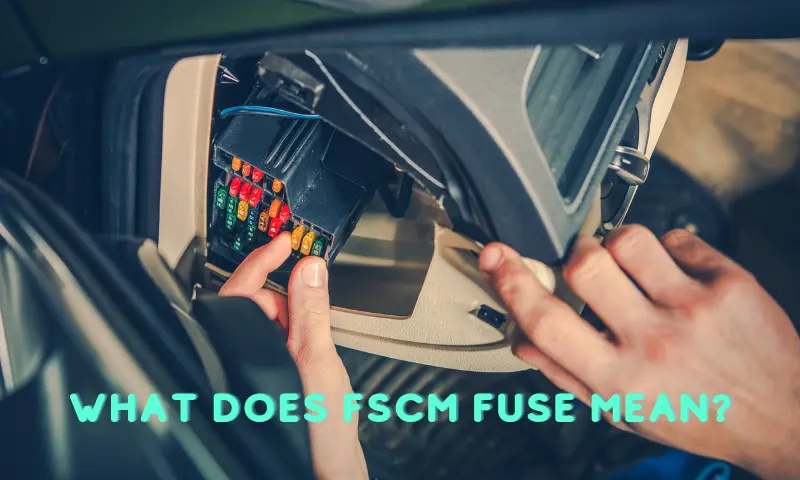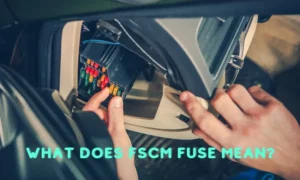With several fuses built into your 2008 Chevy Silverado truck, it might be a little difficult to identify which one does what. Learning a little about the FSCM fuse is a must for car owners and drivers.
What is the FSCM fuse and how does it work? Why will it keep blowing and what fix to apply? There are a few other issues I explain in this article. Stay connected.
What are the FSCM and FSCM Fuse
I think the starting point for us is to explain what the FSCM means. FSCM is an abbreviation for Fuel System control module. As the name implies, the FSCM is a component of the fuel system. It helps run the fuel pump and controls its ground and power.
Again, the module primarily maintains and controls the amount of fuel pressure your car pump receives. Moreover, the FSCM ensures that the pulse width of your car’s fuel pump is regulated. It works both in direct fuel injection and port injection systems.
What’s more, the location of the module depends on the car you’re using. However, in most modern-day cars, the FSCM system is located beneath your car’s spare tire. If you drive a 2008 Chevrolet, you may also find the module in the frame rail close to the tire.
The FSCM fuse performs the same functions as all standard fuses: protect components against the electrical surge. Your car’s fuel pump control module receives its power from the FSCM fuse. What does that imply? Without the fuse’s power supply, there won’t be fuel, and if there’s no fuel, your car won’t start.
Why Does FSCM Fuse Keep Blowing?
Moisture presence
One main reason your FSCM fuse can keep blowing is the presence of moisture in it. Once water gets into the panel of the fuse, it will corrode circuit breakers. The electrical wiring also suffers from corrosion. The interior and bottom of the panel box can rust due to moisture. Again, continued water leaks into the fuse’s service panel can build up chalky-white corrosion. The corrosion often occurs on the screw inside the panel box.
Short circuit
A short circuit in the red/white wiring of the fuel pump can be responsible for why the FSCM fuse keeps blowing. Also, a shorting-out connector is a potential culprit for a blowing fuse. If the wire to the fuse box from the module is shorted to the ground, the FSCM fuse will keep blowing. The fuse, as I earlier said, supplies power that actuates the fuel pump. Once the amount of current needed is lacking in the FSCM fuse, there could be overheating. Fire or a potential explosion in the fuse is a possibility. Hence, a constantly blowing fuse is inevitable.
Overload circuit
While short can cause your FSCM fuse to blow, overloading isn’t left out. The fuel system control module and other powerful plug-in components of the system can draw excessive power from the circuit. If there are too many connectors connected to the FSC module, the circuit loses too much power, causing the fuse to blow.
Damaged Control Module
Your FSCM fuse will continue to blow if the module itself has gone bad. Typically, power goes out from the fuse to the module. Unused power gets back to the fuse, leading to excessive power that can blow the fuse. The control module can get worse due to poor wiring, under-the-vehicle position, debris, contaminants, overheating, and vibrations. Once the exterior shell of the control module corrodes, it may cause the module’s electronic circuits to fail.
How to Troubleshoot a Blown FSCM Fuse
While the FSCM fuse rarely gets bad, it’s, however, not insulated from the issues other auto fuses face. When it becomes faulty, there are a few ways to troubleshoot and fix it. These steps can also help prevent the fuse from blowing.\
- Connect the black ground to the pink ground
- Connect the Red and white (+ve) battery cables to the fuel pump
- Inspect the FSCM for a signal from the fuel pump
- Locate the (dark) green and white wire using a test light that connects to the wire
- Turn the key to the ‘On’ position
- Check if the powertrain control module sends signals to the fuel pump. If this happens, you’ll see the test light illuminate.
In case the FSCM gives off no power at the dark green or white wire, the head straight powertrain control module (PCM)
- At the PCM, check the black connector to see if it has up to 12 volts.
- Turn the key on in the dark green and white wire. The PCM should produce power
- If the PCM produces power and the FSCM isn’t working, then you need to check the wire if there’s a cut
- Repair the cut or replace the wire
- In case the PCM has no power, it’s possibly gone and you’ll need to replace it with a preset system.
FAQs
What is the FSCM error code?
In most vehicles, the most common code for FSCM is 9069E. Using a diagnostic tool to scan your vehicle for a faulty Fuel System control module will show the P069E code. The code indicates that there is a problem with FSCM. Usually, the check engine light will illuminate once the code is flagged. The engine idling speed will fluctuate. Other symptoms include no start or hard start.
Final Thoughts
So far, I’ve explained what the FSCM fuse means. I’ve also offered insights into the location of this fuse and what to do when it gets burnt. You’ll have come to know that the location of the FSCM on GM may likely be different from Chevy Silverado.
No doubt, the function of an FSCM fuse is the same in all cars. The next time someone asks you, ‘what does the FSCM mean?’ you should be able to answer without blinking an eyelid. I hope you can apply the tips here to maintain your newly acquired vehicle.







